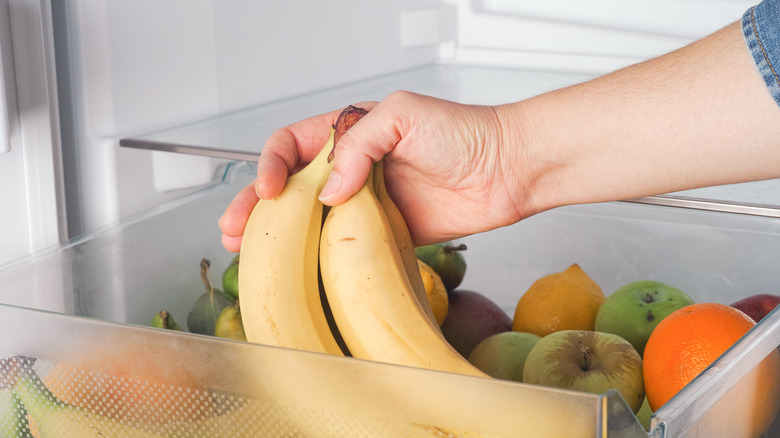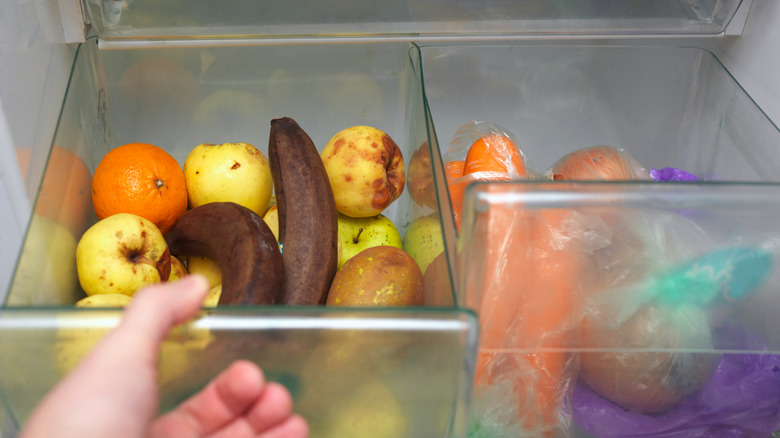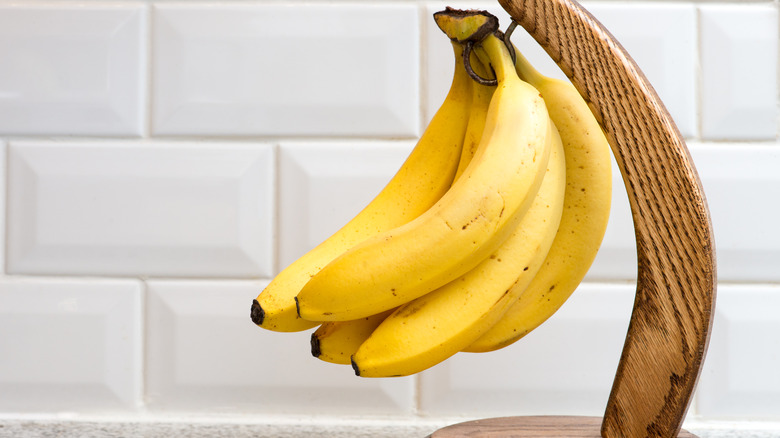When You Should Be Putting Bananas In The Fridge
With their bright yellow color and tropical charm, bananas are a pantry staple in households all over the world. Their subtle sweetness makes them ideal for pancakes, muffins, cakes, smoothies, and other goodies. Unfortunately, you can't keep them around for too long because of their short shelf life. Unlike oranges, lemons, and other fruits, bananas are at their peak freshness for only two or three days or even less on the countertop.
On the positive side, there are plenty of delicious uses for overripe bananas. With its soft texture, the fully mature fruit is perfect for homemade ice cream, puddings, sorbets, oatmeal, or cheesecake. But life gets busy, and you may not be able to use your bananas before they go bad (which can happen pretty quickly). One solution is to put them in the fridge to slow down their ripening. The problem is that they may lose their flavor and become inedible if you refrigerate them too soon.
You can refrigerate bananas, but there's a caveat
Bananas are temperature-sensitive and should be stored at around 56 to 58 degrees Fahrenheit to maintain their flavor and texture. Therefore, they belong on the counter or in a cool, dry place — at least until they are fully ripe. Storing bananas in the fridge can delay ripening and extend their shelf life, but there's a caveat: the fruits may develop chilling injuries and turn brown, as noted in a 2022 study published in the journal Frontiers in Plant Science.
Chilling injuries are more common in mature green bananas. This problem occurs when the fruit is stored at temperatures below 55.4 degrees Fahrenheit, and it can significantly affect its color, flavor, and overall appearance, according to 2018 research presented in Postharvest Biology and Technology. Therefore, it's best to store your bananas at room temperature until they ripen, and then place them in the refrigerator for one or two days. Their skin may become darker, but the ripening process will slow down.
Alternatively, you can freeze bananas for up to six months. This option works great for smoothie and banana bread lovers and offers a lot of flexibility. You can peel and mash or slice the bananas before freezing them, or you can keep the peel on. If you feel like drinking a smoothie, just pop a frozen banana and other fruits in the blender. You can also dip the peeled fruit into melted chocolate and then freeze to make popsicles.
Use these hacks to keep bananas fresh for longer
Keeping bananas fresh is easy, especially if you buy them unripe. Like apples, peaches, and other fruits, bananas produce ethylene gas. This compound is released from their stems and speeds up the ripening process. Hanging your bananas or covering their stems in plastic wrap can slow down the release of ethylene and delay ripening. Ideally, you should store them away from other ethylene producers, such as cantaloupe, tomatoes, pears, figs, or plums.
Another option is to use a banana bag to slow the ripening process. If you go this route, you can store the fruits in the refrigerator before they are fully ripe. Or you can buy green bananas, which have a longer shelf life than their ripened counterparts. Green bananas are safe to eat and can be used in various homemade desserts, from popsicles and energy bars to brownies and cupcakes.
As a rule of thumb, store these fruits away from heat and sunlight. Place them in a cupboard, on a closet shelf, or in the pantry to keep them fresh for longer. If you buy them in bulk, keep them in the garage or cellar. Just make sure the room temperature doesn't exceed 58 degrees Fahrenheit.


